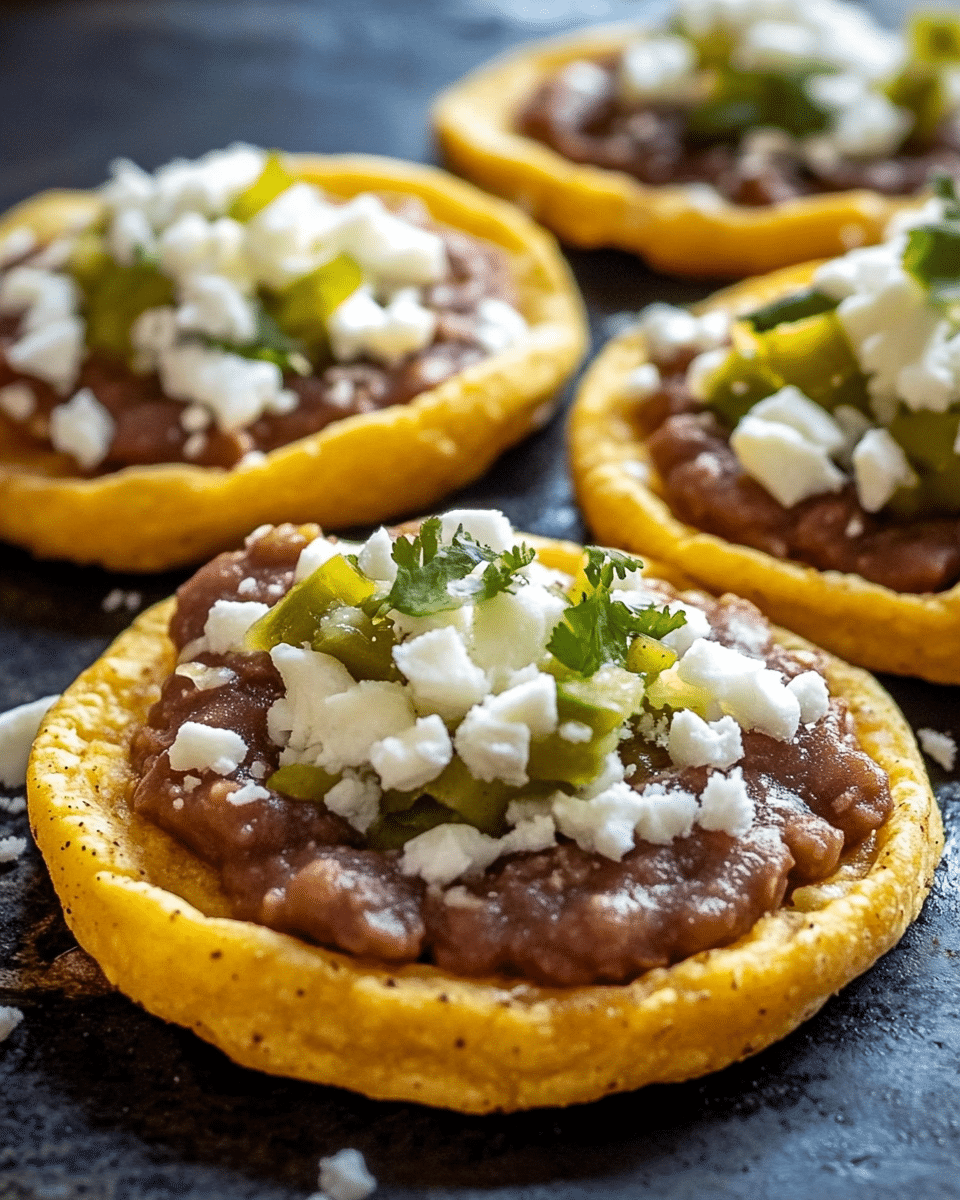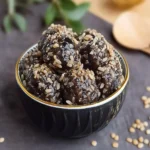Sopes are one of Mexico’s most beloved antojitos, offering the perfect balance between texture and flavor. The base, made from masa harina, is lightly fried to achieve a golden, crisp exterior while keeping a tender, pillowy center. Once shaped with a shallow rim, it becomes the perfect edible vessel for creamy refried beans, salty queso fresco, and a cooling drizzle of crema.
This dish is as versatile as it is comforting. You can serve sopes as a hearty appetizer, a quick lunch, or as part of a vibrant dinner spread. Top them with shredded lettuce, salsa verde, or even sautéed mushrooms for variety. No matter the occasion, these sopes deliver a bite of authentic Mexican street food flavor right to your table.
Full Recipe:
Ingredients:
-
2 cups masa harina
-
1 1/2 cups warm water (adjust as needed)
-
1/2 teaspoon salt
-
1 cup refried beans (homemade or canned)
-
1/2 cup queso fresco, crumbled
-
1/4 cup Mexican crema or sour cream
-
1/4 cup fresh cilantro, chopped
-
2 tablespoons vegetable oil
-
1/2 cup shredded lettuce (optional)
-
Salsa or hot sauce, for serving
Directions:
-
In a mixing bowl, combine masa harina, salt, and warm water. Mix until a soft dough forms. If the dough feels dry, add water 1 tablespoon at a time.
-
Divide the dough into 8 equal portions and roll each into a ball. Flatten gently into discs about 3 inches wide.
-
Heat a dry skillet or griddle over medium heat. Cook each disc for about 1-2 minutes per side until lightly browned.
-
Once all discs are cooked, use your fingers or the edge of a spoon to pinch up the edges to form a shallow rim.
-
In a skillet, heat vegetable oil over medium heat. Fry the sopes for about 1-2 minutes per side until golden and slightly crisp. Drain on paper towels.
-
Spread a generous layer of refried beans over each sope.
-
Top with queso fresco, a drizzle of crema, chopped cilantro, and optional shredded lettuce.
-
Serve warm with your favorite salsa or hot sauce.
Prep Time: 15 minutes | Cooking Time: 20 minutes | Total Time: 35 minutes
Kcal: 210 kcal | Servings: 8 sopes
The Story and Heart of Sopes with Refried Beans and Cheese
Few dishes can capture the warmth, hospitality, and heritage of Mexican cooking like sopes. At their core, they’re simple: a small, thick disc of masa (corn dough), fried until golden, pinched at the edges to form a rim, and topped with flavorful ingredients. But this simplicity is what makes them so special, each bite is a celebration of texture and taste, carrying with it the story of centuries-old culinary traditions.
Sopes are a staple in Mexican street food culture, commonly referred to as antojitos, small cravings or little whims, that people enjoy as snacks, light meals, or even as part of festive gatherings. If you’ve ever walked through a bustling Mexican market or street fair, you’ve likely caught the scent of freshly fried masa, the earthy fragrance of beans simmering with spices, and the tangy brightness of fresh cheese and salsa. That’s the magic of sopes.
Our version today, Sopes with Refried Beans and Cheese, is one of the most beloved and traditional combinations. Creamy beans spread over a warm masa base, salty crumbles of queso fresco, a drizzle of crema, and a sprinkle of fresh cilantro create the perfect bite. They’re vegetarian, hearty, and endlessly adaptable, making them a crowd-pleaser for all occasions.
Cultural Roots and History
The origins of sopes can be traced back to indigenous Mesoamerican cooking traditions, where maize (corn) was not just a staple ingredient but a sacred crop. For thousands of years, corn was nixtamalized (treated with limewater) to unlock its nutrients and then ground into masa to form tortillas, tamales, and other dishes, including early versions of sopes.
Historically, sopes were made thicker than tortillas to hold heartier toppings, making them more filling and portable. They could be cooked over an open flame, fried in animal fat, or toasted on a comal (a flat griddle). Over time, regional variations developed, in some areas, they’re topped with shredded meats; in others, with fresh vegetables, beans, or cheese.
The version we know today, lightly fried with pinched edges, became popular as Mexico’s street food culture expanded in the 20th century. These little corn discs became a go-to snack for busy workers, families on the go, and anyone looking for a quick bite packed with flavor.
Why This Dish Works So Well
Sopes are a textural masterpiece:
-
The base — thick enough to stay soft in the center but crisp around the edges.
-
The beans — velvety, seasoned just right, and deeply savory.
-
The toppings — bright, fresh, and full of contrast, from the creaminess of crema to the salty crumble of queso fresco.
Every component balances the others, making each bite exciting. Unlike tacos, which can get soggy quickly, sopes hold their structure, letting you take your time and savor the flavors.
And perhaps the most beautiful part? They’re infinitely customizable. Swap in sautéed mushrooms for beans, add shredded chicken, or make a spicy salsa roja to drizzle on top. This adaptability is why sopes remain a household favorite in Mexico and beyond.
Ingredient Insights
To truly understand and appreciate this dish, it’s worth looking closer at each key ingredient:
Masa Harina
Masa harina is a fine corn flour made from nixtamalized corn. This process not only improves flavor but also boosts nutritional value. It’s the foundation of sopes, without good masa harina, you can’t get the right texture. Brands like Maseca are widely available, but artisan versions often have a deeper corn flavor.
Refried Beans
Refried beans (frijoles refritos) are made by cooking pinto or black beans, then mashing and frying them in oil or lard with onions, garlic, and spices. They’re smooth, rich, and deeply satisfying. In vegetarian versions, vegetable oil replaces lard without losing much depth of flavor.
Queso Fresco
This fresh, crumbly cheese adds a salty, milky note that brightens the dish. It doesn’t melt like cheddar or mozzarella, instead, it stays soft and slightly moist, providing a pleasant contrast to the crisp masa.
Crema
Mexican crema is similar to sour cream but less tangy and slightly thinner. It adds a cool, silky element that balances the earthy beans and savory masa.
Fresh Herbs and Veggies
Cilantro, lettuce, radishes, and onions are common garnishes, adding freshness, crunch, and bursts of color to the plate.
Pro Tips for Perfect Sopes
-
Dough Consistency is Key – Your masa dough should feel soft and pliable, not dry or sticky. If it cracks when shaped, add a tablespoon of water; if it sticks to your hands, dust with a little more masa harina.
-
Pre-Cook Before Frying – Cooking the masa discs on a dry skillet before frying ensures they’re cooked through inside, not just crisp on the outside.
-
Pinch While Warm – Pinching the edges to form rims is much easier while the masa is still warm and flexible.
-
Don’t Over-Fry – A quick fry is enough. Over-frying can make them tough rather than tender inside.
-
Serve Immediately – Sopes taste best when freshly made. If you must make ahead, reheat briefly on a skillet before topping.
Serving Ideas and Variations
While the classic bean-and-cheese topping is beloved, you can dress sopes in countless ways:
-
Meat Lovers – Add shredded chicken tinga, pork carnitas, or beef barbacoa.
-
Veggie Delight – Top with sautéed zucchini, mushrooms, or roasted peppers.
-
Breakfast Sopes – Add a fried egg and a spoonful of salsa verde for a morning twist.
-
Seafood Sopes – Use shrimp sautéed in garlic and lime.
-
Street Market Style – Load with beans, lettuce, crumbled cheese, salsa, and pickled jalapeños.
Salsas are also essential, a spicy salsa roja, smoky chipotle salsa, or tangy tomatillo salsa can transform the flavor profile.
Pairing Suggestions
Sopes can be part of a larger Mexican meal or enjoyed on their own. Pair them with:
-
Drinks – Horchata, agua de jamaica, or a cold Mexican beer.
-
Sides – Elote (Mexican street corn), guacamole, or a fresh cactus salad.
-
Desserts – Flan, tres leches cake, or buñuelos for a sweet finish.
Nutritional and Dietary Notes
Sopes with beans and cheese are naturally vegetarian and gluten-free (as long as the masa harina is certified gluten-free). They’re a good source of plant-based protein from the beans and provide healthy carbohydrates from the masa. Queso fresco adds calcium, while fresh vegetables contribute fiber and vitamins.
For a lighter version, you can bake the masa discs after pre-cooking instead of frying them, or use reduced-fat cheese and crema.
A Dish That Connects Generations
For many families, sopes are more than just a meal, they’re a tradition. Grandparents teach grandchildren how to pinch the masa edges just right, parents pass down secret salsa recipes, and everyone gathers around the table to enjoy them hot off the skillet. It’s a dish that carries nostalgia, love, and a sense of community.
Cooking sopes at home allows you to not only enjoy a delicious meal but also to take part in a cultural tradition that has been cherished for centuries. Whether you’re making them for a casual weeknight dinner or a festive weekend gathering, the act of preparing sopes brings people together.
Conclusion
Sopes with Refried Beans and Cheese are a perfect example of Mexican cuisine’s ability to turn simple ingredients into something extraordinary. With a crisp-yet-soft masa base, creamy beans, salty cheese, and fresh toppings, they’re satisfying without being heavy, versatile without being complicated.
By learning to make sopes at home, you’re embracing a piece of culinary history and adding a delicious, customizable recipe to your cooking repertoire. Whether you stick to the traditional version or experiment with your own toppings, these little masa boats are sure to win hearts, one bite at a time.






